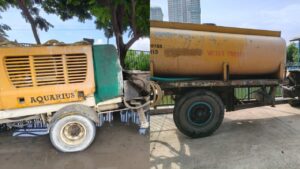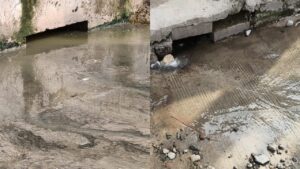The flooding at Malkam Cheruvu was not an isolated incident but part of a pattern where short-term infrastructure projects disrupted long-standing ecological systems, leaving communities more vulnerable to seasonal extremes.
Published Aug 15, 2025 | 8:00 AM ⚊ Updated Aug 15, 2025 | 8:00 AM

Malkam Cheruvu.
Synopsis: The Malkam Cheruvu was part of a larger hydrological network, acting as a natural drain for Durgam Cheruvu before emptying into Himayat Sagar. The lake’s ability to function its natural role has been compromised by encroachments and alterations to its natural channels. And hence, the flooding.
Hyderabad’s ongoing monsoon season has brought intense and persistent rainfall, with Rangareddy district among the worst affected. The downpour has caused widespread waterlogging, severely disrupting traffic and daily life across several arterial routes.
One of the most severely impacted stretches was near Malkam Cheruvu, a lake bordered by both public and private developments.
Malkam Cheruvu is surrounded by a park developed by the Greater Hyderabad Municipal Corporation (GHMC) and Aparna Builders, with roads running along all sides. These roads have openings to drain stormwater directly into the lake. However, during the recent spell of heavy rain, two major routes — the Old Mumbai Highway and the road to the right of the lake — were inundated.
The flooding was so severe that traffic slowed to a crawl, and some stretches became impassable. Even days later, traces of the inundation were visible: large puddles lined the roadside, and water tankers and pumps could be seen as part of the state’s ongoing efforts to clear the accumulated water.
For many residents, commuters, and emergency responders, the incident was a stark reminder of the city’s vulnerability to extreme rainfall events, compounded by drainage limitations and rapid urban development around natural water bodies.
The recent flooding near Malkam Cheruvu left many residents in the surrounding low-lying areas struggling to cope with the sudden watery situation. For those living along the road to the right of the lake, the downpour transformed their surroundings into an extension of the water body.

Ailamma’s household items that were damaged by floodwater.
Ailamma has been living in a makeshift shack in the area for three years. Speaking to South First, she described the rains as unlike anything she had experienced before.
“Rains have always been bad, but we’ve never seen anything like this. This road became a part of the lake that day,” she recalled.
With water entering her home and no safe space to stay, she and her family took shelter in nearby buildings for three days. The disruption left her without work, and she had to depend on the residents of nearby apartments for her food.
Her neighbour, Lakshmi, faced similar hardship. The location of her home, in a relatively lower pocket of the road, meant water from multiple directions converged at her doorstep.

Ailamma (Left) and Lakshmi.
“We lost a lot of clothes, other things, and even our footwear. Everything is damp,” she told South First, adding that the stagnant water lingered until her employer arranged for a pump to drain it out.
Both women emphasised that the flooding was not just a brief inconvenience, but a multi-day ordeal that destroyed belongings, disrupted livelihoods, and left homes uninhabitable. The water also tore down a wall at a nearby construction site.
The locals’ account was corroborated by Vinodha, a coconut vendor who frequents the street. “The water rose above my knees. I had to wade through the water with my cart. I had no business that day, and it was very inconvenient. While this happens every year, this year was particularly bad,” she told South First.
On the day the floodwater covered the Malkam Cheruvu area, the Hyderabad Disaster Response and Asset Administration (HYDRAA) mobilised around 60 personnel to manage the situation. Their role extended beyond pumping out water; they had to regulate chaotic traffic, assist stranded residents, and ensure no one was injured while navigating the submerged streets.

Water pumps and tankers stationed in the area.
A HYDRAA worker, who requested anonymity, recalled the challenging conditions. “About 60 workers arrived here to help regulate traffic and keep the people safe. I helped two to three people who fell while wading or driving through the water,” he told South First.
The water, murky and waist-deep in places, concealed potholes, debris, and open drains, posing constant risks to pedestrians and motorists alike.
The worker explained that the area’s topography made it particularly vulnerable during monsoons. “Water collects here from everywhere, from Hitec City as well as Film Nagar, making it hard to manage. Even the drains were overwhelmed, causing massive waterlogging,” he noted.
Besides physical hazards, the team withstood the strain of working continuously in wet gear, the rain, and contaminated water. Coordinating with municipal staff and using pumps, they worked late into the night to reduce water levels enough to reopen the affected roads.
The pumping efforts extended into the next day as well, with personnel stationed for a few more days. However, HYDRAA holds that the flooding arose when the channel directing outflow from Malkam Cheruvu was overwhelmed.
Environmental activist Lubna Sarwath has been closely tracking the flooding at Malkam Cheruvu and has taken the matter to court, filing a Public Interest Litigation (PIL), flagging encroachments in the area. She told South First that the situation was a “man-made disaster,” pointing to a combination of state decisions and private development as the root causes.

Inlets along the road, draining water into the lake.
Sarwath said the Malkam Cheruvu was part of a larger hydrological network, acting as a natural drain for Durgam Cheruvu before emptying into Himayat Sagar. She felt the lake’s ability to function its natural role has been compromised by encroachments and alterations to its natural channels.
“I have an affidavit from the government admitting that they have encroached upon the Full Tank Level (FTL) limits with a road,” she said. “Similarly, Aparna is also responsible for its park.”
She further criticised the government’s practice of replacing natural water channels with pipelines. “The government has taken up a process wherein they are converting the lake’s natural channels of transportation into pipes. How are pipes supposed to handle the flow of a lake?” she questioned, arguing that such interventions fail to account for the volume and speed of stormwater during heavy rains.
Sarwath’s view underscored the tension between urban development and environmental sustainability in Hyderabad. For her, the flooding at Malkam Cheruvu was not an isolated incident but part of a pattern where short-term infrastructure projects disrupted long-standing ecological systems, leaving communities more vulnerable to seasonal extremes.
(Edited by Majnu Babu).
